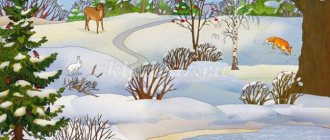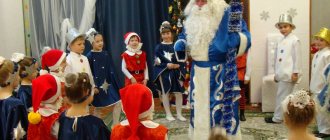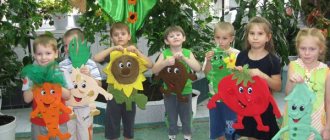Olga Andreeva
Card file of winter walks in the preparatory group
Observation #1
Observing changes in nature. Offer to look for signs of winter on your own.
Riddle: Powdered the paths,
I decorated the windows.
Gave joy to children
And I went for a sledding ride. (Winter)
Didactic game “Who is bigger?”
- practice selecting definitions for nouns.
What words can you use to describe winter? What's winter like? (magical, fairy-tale, snowy, frosty, blizzard, sparkling, magical winter, cold, beautiful, etc.)
Monitoring seasonal changes
Goals:
• form ideas about changes in nature at the beginning of winter (the night becomes longer and the day decreases)
;
• learn to distinguish the characteristic signs of the beginning of winter, recognize them in poems.
Experimenting and experiences while walking in winter
Preschool age is characterized by a special interest in the world around us. Often, a child cannot notice some fundamental things on his own, so it is important for a teacher to teach him not only to look, but also to see. Theoretical knowledge should be supported by visual material and experiments that can enrich children’s knowledge.
Experimentation on walks is divided into two types:
- Frontal - when children have several objects to observe and compare independently. For this type of observation, it is recommended to have two teachers monitoring the students, especially if the group is large.
- Demonstration - the teacher holds in his hands the object that has been selected for teaching. The teacher demonstrates the object and conducts an educational conversation. This method dampens initiative and activity; as a rule, preschoolers are not very interested in activities in which they must only observe without participating.
Math lessons for children 5-6 years old, examples and tasks
Important! Experiments that will be conducted with children must be selected in accordance with their development and age.
Experiments for preschoolers are not entertainment, but a way of teaching children, their acquaintance with the environment and life. Such walks can be done in the format of an open lesson, with the invitation of parents.
Bottom line
Educator: Guys, did you like our meeting with nature today?
What did you like? What new things have you learned? What have you learned? Why were you surprised? We have not yet revealed many secrets of nature, many surprises await us ahead. But “Winter” has prepared another little surprise for us. Do you think this surprise is for one or for all? But you need to find it, and the arrow pointers will help you with this. And when you find it, don’t forget to call all the guys so that they can see it too (the guys find sweet gifts in the chest).
Author: Ibragimova Gyuzeliya Nailovna Position: teacher of the highest qualification category Place of work: MBDOU kindergarten No. 71 in the city of Kostroma Location: Kostroma city, Mr. Davydovsky 2
Date modified: 09/13/2019 Date of publication: 09/13/2019
Card index of winter walks in the middle group
In the Russian Federation, all educational programs for preschool organizations are consistent with the Federal State Educational Standard (FSES) - federal state educational standards. They provide:
- Unity of the educational system.
- Continuity of training programs.
- Spiritual and moral education.
Walk in a medium group in winter
A walk in kindergarten in winter begins with proper organization. The teacher asks about the time of year.
Additional Information! Children find signs of winter in the surrounding nature. Riddles are asked. The weather condition is noted. A winter walk in a dhow in winter should be as productive as possible.
Observations during a walk in the middle group in winter are described in detail in the card index.
Card index of walks. December
| December | Observation on a walk: middle group, winter-December. | Didactic game | Outdoor game | Individual work | Work |
| day 1 | Trees. The teacher draws the children's attention to the snow covering the trees. | “The most attentive!” - develops hearing and perception of verbal instructions. | “Step over the stick” - trains children to step over an object. | Run along the line. | Clearing paths and paths of snow. |
| day 2 | “What changes have taken place on the street?” - formation of elementary ideas about changes in nature in winter, speech development. | “Fluffy bunny in a snowdrift” - repeat the movements after the teacher. | “Where does the sound come from?” - develops auditory attention. Definition of sound. Orientation in space. | Game "Find the toy." Learning to walk in the direction told by the teacher. | “We remove snow with shovels.” |
| day 3 | Snowfall. Grove. Forming an idea of the weather. New words: beautiful, snow, winter, spinning, cold. | “Run back and forth”: children run in the indicated directions. | “Quiet-loud” - develops the voice. Ability to speak either quietly or loudly. | Repetition of M. Poznansky’s poem “It’s snowing.” | Removing cones from the area. |
| day 4 | Birds. Feeding. Nurture care for birds. | “Quiet than everyone else?” Walking on toes. | "The secret is in the bag." Children determine the type of grains by touch. | “Fast legs walked along the road...” Develops coordination. | Hanging feeders. Education about caring for birds. |
| day 5 | Cats. Involving supervision of pets. Cultivate care for them. | Physical exercise. "Catching up." The lesson is aimed at strengthening physical health. | “Bring it and find it.” Develops in children a sense of responsibility in relation to the teacher’s requests. | Jumping in one place. | "Cleaning the gazebo." |
| day 6 | “Winter is winter.” "Our kindergarten in winter." Strengthen ideas about snow, winter, frost. | “The New Year is coming to us.” Comparison of winter, snow with the holiday. | “Yes and no” - reinforce the rules of behavior when walking in winter. | Repetition of poems for the New Year holiday. | Raking snow into a pile - preparation for making buildings from snow - involves children in labor. |
| day 7 | Passers-by. Children's attention is drawn to passers-by with packages, gifts, and Christmas trees. Everyone is waiting for the holiday. | “Find the same thing.” Mindfulness training. | "Beautiful Christmas tree." Children imitate a Christmas tree. | High jump. | Decoration of buildings with multi-colored ice floes. A desire to decorate the garden area is fostered. |
Note! A winter walk is held in kindergarten according to the requirements of the Federal State Educational Standard.
Ability to manipulate objects while playing with snow
Card index of walks. January
| January | Observation on a walk: middle group, winter-January. | Didactic game | Outdoor game | Individual work | Work |
| day 1 | Weather changes. The idea of winter | "Wind and Snowflakes." Action as directed. | "Blizzard-winter." Imitation of wind sounds. | “Walk straight along the path.” | Removing branches from the area. |
| day 2 | Passers-by's clothes. Why is everyone dressed so warmly? The connection between cold weather and clothing. | “The little bunny is running” - Children learn to follow the teacher’s movements, clap, jump. | “Tick-tock” - Correct pronunciation of “k”, “t”, “i” is developed. | Poem by N. Sakonskaya “Where is my finger?” Teach agility and speed. | Sprinkling paths with sand - explain to children. Explain why sand is needed on the paths. |
| day 3 | Birds. Teach a class of preschoolers how to care for birds in winter. | "The Crow and the Puppy." Actions on a signal. | "Little Helpers" Getting to know diminutive words. | Repeat poems about the Christmas tree. | Collect toys. |
| day 4 | Excursion to the forest belt. | "Throw the ball." Exercises in catching a ball at a distance of 100 cm. | "My first essay." Describe verbally what winter is. | Charging in frosty air. | Collect cones. Collect specified items from the snow |
| day 5 | Snow. Familiarization through games. | "The ball is rolling." Develop coordination in running and walking in the snow. | "Fox nose" Depict winter animals. | Walking in the snow. | "Sweep the gazebo" |
| day 6 | Birds. Taking care of them. Learn types. Recognize body parts. | "Mama Crow" | “What birds do you know?” Find the bird from the picture. | Imitation of birds. | Pour grains into feeders. |
| day 7 | Snow. Children's idea of snow. Guiding questions: “What can be done with it?”, “Where does it fall?”. | "Snow is flying." Teach children to pay attention to everything around them. | “There’s so much here.” Attention to surrounding objects. Pronounce the names. | Throwing snow. | Help the janitor clear the paths. Learn to help elders to each other. |
Drawing lesson on the topic “Beautiful Bird” in middle groups. Notes with card files must be certified by higher state stations. structures.
MAGAZINE Preschooler.RF
“How do you know winter?” Open demonstration of the walk in the preparatory group(Children get dressed and go outside)
Educator: “Come in, kids: Both girls and boys! I ask everyone to stand in a circle - take each other’s hands!
Look at each other and give smiles! I didn’t come to you alone - I brought guests to the site!
Say hello, guys (children say hello)
(A letter is brought out, the teacher reads):
- Hello, preparatory group guys! Employees of a research institute are writing to you. We are studying the Arctic and the characteristics of the winter season. On December 17, an international conference on this issue began in Moscow. Research by scientists on studying the characteristics of winter in desert, steppe, and middle zone conditions was presented. But unfortunately
no one presented studies of the characteristics of winter in the North. The institute staff found out that you guys live in the north and invite you to take part in the conference.
Educator: Guys, do you agree to take part in the conference (Yes)
-How can you and I take part in the conference and talk about our northern winter?
Children: Draw, go, fly.
Educator: Let's draw and send the drawings by mail, it will take a long time! Let's go by train - everyone will want to go, there may be no tickets! By plane - expensive!
-What do we do? After all, you know so much about our winter (Bring the children to the conclusion that you can shoot a video and send it) You have watched so many programs and films about different seasons on TV. Let's try to make a movie ourselves! Tell me the professions of the people who participate in the creation of the film (children's answers)
Educator: Guys, fortunately for us, I have a familiar cameraman who will help us shoot a film, edit it and send it to Moscow (a cameraman appears with a camera)
Educator: Guys, are you ready to tell the conference participants about our northern winter (Yes) Then answer loudly, clearly, in a complete sentence!
- What time of year is it now in the North?
- What signs of winter do you know?
- What are the winter months?
- What kind of winter do we have in the North?
- How are animals ready for winter?
- How do trees winter? Why are trees dormant in winter? Why can't you shake snow off branches? What can we do to prevent tree roots from freezing? Let's ask our boys to brush the roots of the trees (The boys take shovels and brush the tree trunks on the site)
- (addressing the girls) Why are there few birds outside in winter? What birds stayed with us for the winter? What do you and I do to help birds in winter? Let's pour grain into our feeders (together with the girls we pour grain into the feeders, then, after finishing the work, the girls praise the boys, the boys praise the girls)
- What games and fun do children play in winter (children's answers)
(a low-mobility game is played, children perform movements according to the text)
“Winter has finally come! The houses have become white! It's snowing outside, the janitor is sweeping the street!
We go sledding, make laps on the skating rink, deftly ski, and all play snowballs! "
Educator: Well done, guys! And you also want to play (Yes). But first, let's remember the rules of safe behavior on the site during games. (children's answers)
(A game of medium mobility is played “Hit the target.” Children are divided into two teams, each pair throws snowballs at the target).
Educator: Now, guys, guess my riddle!
"Transparent like glass,
Don't put it in the window! "(ice)
-You will find out if you guessed correctly if you read the inscription in the ice secret (Children take the “secrets” - pre-frozen water in small bowls, in which there are pieces of paper with the inscription “ice”, read; it means the riddle was guessed correctly)
Educator: (experimental activities are being carried out to identify the properties of ice) Guys, can you clearly see the inscription? Were you able to easily read the word “ice”? So, what conclusion do we draw?
Children: The ice is transparent, you can clearly see everything through it!
Educator: Stroke the ice with your hand. What are they like (smooth, slippery)
Educator: Now let's try to get some pieces of paper. What needs to be done for this (break the ice) So what kind of ice is it (breakable, fragile)
Educator: What do you think is easier: water or ice (Children throw pieces of ice into a bowl of water and find out that pieces of ice do not sink, which means they are lighter than water)
Educator: And also, guys, ice can be dangerous! Why ice is dangerous (answers)
-Well done boys! You correctly named all the properties of ice, I think the institute staff remembered everything! What would our northern winter be like without a snowman (children perform movements according to the text)
“Tra-ta-ta, tra-ta-ta, we’re making a snowman! We will put the com on whom. Let's draw eyes, insert a carrot nose. We'll find the hat.
What a white, fat snowman! "
(Snowman appears)
Snowman: Hello guys! The magpie told me that you are filming a movie here! I want to participate too! Who knows everything about winter if not me! This is my favorite time of year! The magpie told me that you told and showed a lot here! And I myself want to make sure that you know everything! Here's your first task:
1) Select words related to the meaning of the word “snow”: “Quietly, quietly, as in a dream, it falls to the ground. (snow) All silvery fluffs are sliding from the sky. (snowflakes) This is fun for the guys - it's getting stronger. (snowfall)
It’s like he’s dressed up in a white down jacket. (snowman)
In the snow, look, with a red breast. (bullfinches)
Task 2:
-Which is more: snowfalls or snowflakes?
-Which is less: winters or winter months?
Snowman: Well done, guys! I see that the magpie did not deceive me!
Educator: Snowman, do you want to play with us (The outdoor game “Snowman” is played, the children choose a leader with a counting rhyme)
“The snowman is sitting, sitting.
He dozes in the morning and sleeps during the day.
In the evenings he waits quietly, at night he comes to scare everyone! "(2-3 times)
Snowman: Guys, thank you for the game, but it’s time for me to leave! I brought you a winter treat - snowballs as a gift, but you eat them after a walk in the group (leaves) Teacher: Well, guys, it’s time for us to finish our film! Let’s say “thank you” to our cameraman; today he will edit everything and send our film to the conference participants, who will watch it today!
(The guests leave, the walk continues)
| Next > |




